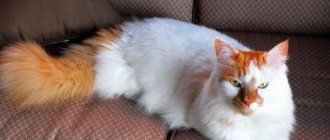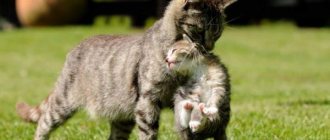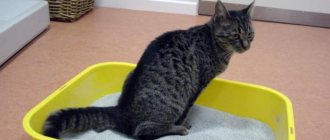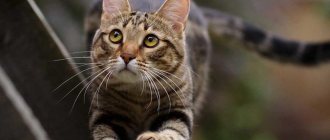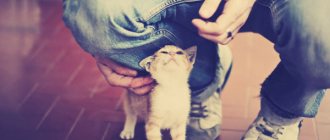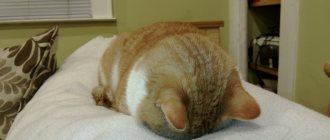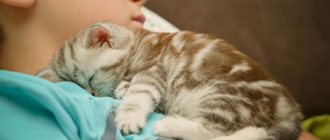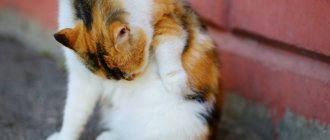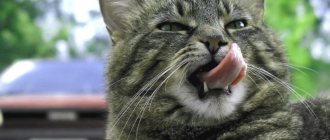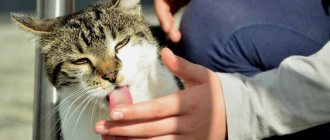Why does a cat lose weight with a good appetite: possible reasons
Many breeders panic if they see that a cat is losing weight with a normal and balanced diet.
In most cases, there is no concern if, for example, your pet leads an active lifestyle and is often on the move. He simply has a normal metabolism and burns all the calories.
A skinny kitten is not always a cause for concern.
The kitten may not gain weight yet.
It is useless to expect a baby or teenage kitten to gain weight and become round.
By about 8–10 months, their skeleton, spine, and posture are formed. During this period, the animal is still, so to speak, “stretched” to the required size, and after formation it can begin to gain weight.
If you have an adult animal, and it loses weight with a healthy diet, then the reasons may be the following.
Health problems as a cause of weight loss
- Dysbacteriosis. Some pets have metabolic problems from birth, while others suffer from it due to poor quality nutrition. In such a situation, it is necessary to adjust the cat’s menu and add vitamins and probiotics to it. The doctor will help you determine which probiotics your mustache needs after passing the tests.
- Presence of microparasites. Deworming needs to be done regularly.
- Dental problems. Inflammatory processes in the gums and tartar cause discomfort and the cat (even a hungry one) refuses treats. Here you need the help of a specialist.
- Oncology. Neoplasms in internal organs have a bad effect on a cat's health. If you don’t understand why your domestic cat is thin and not getting better, then first of all rule out the presence of tumors and do an ultrasound.
- Presence of internal diseases and infections. In addition to emaciation, your pet may experience other symptoms: vomiting, fever, change in stool, refusal of treats, etc. - all this signals some kind of pathology (disease of the gastrointestinal tract, liver, kidneys, etc.). At the same time, the cat may have “caught” an infection - panleukopenia, viral hepatitis, etc. Timely diagnosis is necessary here. Curing the disease will lead to weight gain.
What to do if your cat is constantly begging for food?
When cats wake us up at four in the morning, demanding food, screaming like crazy, or non-stop poking their foreheads at their owner, we give up. The cats have trained us well, they know very well which buttons to press to get what they want! Here are some tips for pacifying annoying Persians or irrepressible Siamese:
- Do not use automatic feeders. It is quite obvious that the automatic feeder for the fat tailed man is a machine filled to the brim with candies.
- Pet your cat or play with her when she begs for food. Many cats perceive food as equivalent to their owner's attention, and you may find over time that play replaces the cat's meal.
- Feed your animal in smaller portions, but more often, so you can provide a late dinner for a cat who likes to wake you up in the morning. Divide your total calories into four to six small portions. The most important thing is not to give your cat food in excess of the prescribed amount.
- If the bowl is empty and the cat won't calm down, put a couple of pieces of food in the bowl. A couple of pieces, not a handful.
- Offer your cat fresh water instead of food. When your cat is persistently staring at an empty bowl, a sip of fresh, cold water can curb her appetite.
Description
In the first years of life, a young male or female cannot, by definition, gain weight. The kitten's skeleton is forming and its body is stretching. Young cats are constantly playing, jumping and moving - they burn calories themselves. The older animal has lost weight because it is not as active. The cat should gain weight, but up to a certain limit.
An older cat may lose a lot of weight for the following reasons:
- The cat has lost weight and becomes ill when the animal gets into a stressful situation. Fear and hostility towards a stranger or another pet completely interrupts the appetite. Recovery will take time, but stress for older cats is also a cause of illness. And more serious than the one when the cat lost weight.
- The cat will lose weight and stop eating and drinking if its teeth are in poor condition. An old cat may lose them altogether. It is recommended to buy specialized food that does not cause problems for an elderly animal and contains additional strengthening vitamins.
- When a cat has lost a lot of weight and is eating regularly, we can talk about worms. Helminths enter the body through water - not every owner makes sure that there is clean liquid in the cat’s saucer. Your pet may become ill. It is important to carry out timely treatment.
Why doesn't a castrated cat get fat?
A cat hisses: the main causes of aggression
There is an opinion among owners of cats that have not yet been neutered that as soon as castration occurs, absolutely everything in the character, lifestyle and behavior of the animal will change.
Cats become calm and even lazy, stop marking, and begin to quickly gain weight.
In relation to probably 70-80% of castrated animals, this opinion is justified, since it is based on the knowledge that after the procedure the hormonal levels change, the cat’s metabolic processes slow down, which means it becomes less energetic. But this doesn't always happen.
Note! If the animal was neutered late, at 1.5-2 years, then there is a high probability that there will be no sudden changes, so the sight of a skinny cat should not be alarming.
The absence of changes in weight is also affected by proper feeding. So, if a cat consumed dry food before castration, then changing the food (switching to natural products) affects the weight (the cat gets fat). If the cat is fed according to the same scheme as before, then no changes occur.
Much also has to do with the breed. British cats immediately after castration begin to consume more food, their body weight quickly increases by 2-3 times. The body weight of a neutered yard cat remains unchanged.
The procedure can affect this parameter, but, like with people, everything is individual, some pets cannot gain weight just because of castration, therefore, if the owner dreamed that he would have a fat and very lazy cat, he may have to be disappointed .
Isn’t it strange that the young kitten is very thin, eats poorly and sleeps often?
Young does not mean healthy.
My boyfriend and I bought a British dog on the market, not the most thoroughbred, but incredibly cute, and only at home it turned out that he was disabled. He couldn't go to the toilet much. For several months they dragged the poor thing to operations and washed up his poop.
If a kitten or adult cat shows poor appetite, is very thin, and gets tired quickly, you should consult a veterinarian. Pay attention to the tail. Healthy, happy animals have a tail like a tube. Weakened or permanently unhappy cats keep their tail between their legs.
It happens that there are no diseases, there is simply some general weakness by nature. In our cats, the weakest kitten could always be noticed in the litter. Some do not even have any easily detectable defect, but there is a natural lack of the will to live. Once we had a cat, very beautiful, she grew normally until she was six months old, but even then you could notice that she was somehow too calm. Physically - completely healthy! But gradually this calm grew into some kind of abnormal passivity. In the end, it ended with us finding her dead in the garden one not so wonderful morning. Nobody understood what the reason was. We decided that our dog had mauled her and damaged her in some way. The dog, of course, didn’t mean anything bad; she also tries to play with all our other cats and cats, and they successfully get rid of her advances. And this cat indifferently allowed anyone to do anything to her...
PS Oh, sorry if I scared you. This, of course, was an out of the ordinary case. Most weak kittens are now completely fine and delight their owners.
Genetic miniature
Experienced breeders build genetic lines so that one of the main characteristics of the breed - resemblance to a teddy bear - is well developed. Thin and scrawny cats are removed from breeding.
The situation is different with pets that are bred without permission, pedigree or prior training of the owner. Suppose the cat was not bought for breeding, she grew up miniature and could be an excellent pet, but the owners decided to make money from her by selling kittens.
How to feed other cats if only one needs to lose weight?
You may find a better solution to the problem, but here are some tips to get you started:
- Feeding cats separately is the ideal solution for such cases. Give your losing cat some diet food in one room and feed the rest in another. When the time allotted for a meal is over - usually from fifteen minutes to half an hour - remove what the animals did not eat until the next feeding.
- Feed a cat that is not overweight at the top, where it is more difficult for an overweight cat to climb.
- Never leave food out in the open unattended. This way you won’t be able to control who eats what and when!
Age affects weight
Aging cats often lose weight, although they do not lose their appetite. The fact that among the tailed “old-timers” there are few who are overweight is a scientifically proven fact. Obesity affects mainly pets who are from 5 to 10 years old.
The peculiarities of cat metabolism are such that at a later age their body does not accumulate excess. Of course, in this case, losing weight may be accompanied by illness and loss of appetite; old people often have sore teeth and gums.
[custom_ads_shortcode1]
When is it time to sound the alarm?
The cat is drooling: the main causes and treatment options
Cats begin to worry about being thin if:
- the cat eats a lot and often, but does not gain weight, it is too light and small for its breed (thin cats do not gain weight);
- the spine can be traced visually (the ridge literally protrudes outward);
- the pelvic bones and ribs protrude, their movement is clearly noticeable when the cat moves;
- the cat’s breath smells unpleasant (obviously, the gastrointestinal tract is disrupted, the kidneys and liver are not functioning properly, plaque or caries may have formed on the teeth);
- there is no fat layer on the chest and back area, only bone;
- the cat does not show usual attention to toys, sleeps constantly;
- the animal has loose stools (if mucus, blood, or undigested parts of food are found in the stool, consult a doctor);
- yellowness or excessive pallor of the mucous membranes is observed, they become gray in color (most likely, weight loss is due to problems with the liver and kidneys);
- more fluid is released from the eyes, nose and mouth than usual, especially when an unpleasant odor appears, a change in the color of the animal’s tears and saliva;
- the temperature rises (hot nose, the cat is lethargic, to check the temperature it is enough to use a regular thermometer);
- the stomach is sunken, hard, tense.
The silhouette of an emaciated cat resembles an hourglass.
When the described signs appear, the animal is weighed (to do this, just place it in a bag and use a steelyard or in a cardboard box, cover the top with something and put it on a regular floor scale).
If the cat always eats well, but is very thin, weighs 1 kg or more less than it should, contact a veterinarian. It is first necessary to take weight measurements for several weeks in a row to make sure that there really is a reason for concern (cats are thin and do not gain weight for various reasons, but most often due to illness).
Deviation or norm?
Before taking any measures, you need to make sure that the pet is really very thin. Each breed has its own average performance. For example, outbred cats weigh from 3.5 to 4.5 kg, British and Siberian breeds - from 5-7, Maine Coons - from 8 to 12.
Lack of weight can be determined by palpating the animal's body. If the ribs are well felt and the fat layer is insignificant, this is a deviation from the norm. In cases where the physiological causes listed below are excluded, consultation with a doctor is required.
An alarming sign is if the cat looks thin visually, its ribs, spine and pelvic bones protrude, and there is no fat layer. The stomach is sunken, and the silhouette resembles an hourglass. Such signs indicate exhaustion of the body. A veterinary examination and serious treatment is required.
A cat loses weight with a good appetite
An active young cat with a good appetite should not gain weight. A pet's athletic, fit figure is a sign of normal metabolism and a healthy lifestyle.
Inexperienced owners, when getting a kitten, are worried that regardless of feeding, the baby will look thin. This is the norm. Up to ten months, the musculoskeletal system is formed in kittens, the body begins to store fats after this process is completed.
We suggest you familiarize yourself with How to inject Flexoprofen for cats
The dangers of excessive fattening
For those owners who want to fatten their pet for their own aesthetic needs - to admire how funny the cat licks or runs - it is useful to learn about the consequences of feline obesity. Since obesity in cats, like in humans, is a disease, a fat cat will sooner or later face health problems, including:
- Diabetes of the second type - being initially not prone to diabetes, your pet can develop it with an incorrect lifestyle and, in particular, nutrition. As a result, the owner will have to periodically inject insulin into the cat in order to avoid a sharp deterioration in his health; Diabetes is one of the most dangerous consequences of overfeeding a cat.
- Cardiovascular diseases - the higher the weight of the animal, the greater the load on the heart. Overweight cats, as a rule, rarely move and prefer a recumbent lifestyle, which only aggravates the situation; Gaining excess weight is fraught with heart attacks leading to heart attack
- High probability of joint injury - any long-distance jumps can result in dislocations, or, in the worst case, fractures. Since the bones and joints of each cat are tailored to a certain body weight, which has its own threshold, going beyond its limits is fraught with all sorts of injuries; Overweight cats have a more difficult time recovering from fractures due to the heavy load on the joints.
- Predisposition to arthritis. Fat animals are the first at risk in terms of the likelihood of becoming acquainted with this unpleasant disease, accompanied by inflammation of joint tissues and deformation of the limbs, not to mention purulent complications; In advanced cases, arthritis can only be treated with a surgical scalpel
- Hypertension - this disease is difficult to diagnose in the initial stages, but its harm to the entire body is very great. In its chronic form, hypertension leads to hypertrophy of the heart muscle, which, with the least favorable prognosis, ends in cardiac arrest.
Keep in mind that a deviation of one and a half kilograms from the norm is already considered obesity and unsafe for the pet’s health. Since pets differ significantly from us in size, they only need to gain a few hundred grams for this to become noticeable. You can read about the process of losing weight in cats on our portal.
Proper nutrition
The main source of vitamins and nutrients that animals need is food. A cat will not get fat if you feed it bread or porridge with water. In order for the animal to gain the required weight, it is fed:
- canned sardines and mackerel (diluted with water, try to choose preservatives without salt);
- boiled eggs;
- regular yogurt without any additives (sometimes yogurt causes digestive system upset, so its quantity is limited);
- high-protein dry food (only extra- and premium-class food is suitable, the rest contain too many unnecessary additives that are more likely to hinder weight gain than to stimulate it);
- beef, rabbit and chicken (clean sources of protein);
- salmon
Proper nutrition is the key to a beautiful pet
Note! In order for an animal to gain weight and be able to recover quickly, it needs taurine, so when choosing dry food, carefully study the packaging to see if it is present in the food.
It is forbidden to give cats:
- raw egg (contains avidin, which interferes with the absorption of vitamin B);
- canned tuna (cheap, but not the best option, since its constant consumption causes digestive system disorders);
- food products containing grapes or raisins (many cats love sweets, but buns are not something that is healthy for the animal);
- bad, not fresh food;
- yeast dough (causes colic in the animal’s stomach).
You can fatten your cat with porridge, but you need to cook it in stew or meat broth. Porridge can also be mixed with boiled fish (capelin, herring, sprat). If the cat is fed chicken meat, then before placing it in the cat's bowl, remove the skin from it.
In veterinary medicine there is such a thing as normal thinness. Some animals are simply physically unable to gain more weight than they should. For others, sudden weight loss indicates exhaustion. Only a veterinarian can name the cause after a comprehensive diagnosis. Cats that are too thin are prescribed supportive therapeutic treatment and diet. In order for the cat to quickly gain the desired weight, he is fed protein-rich food - boiled eggs, chicken meat, balanced dry food.
We invite you to familiarize yourself with Cortexin in veterinary medicine - Phoenix Health
Thinness in cats can be physiological or pathological. In the second case, it is very important to find the root of the problem, that is, the disease that caused the pet to lose weight. But it is worth knowing that in most cases the pet loses weight and cannot gain weight due to physiological reasons associated with poor nutrition, anxiety, metabolic disorders, etc. You can understand in more detail the question of why a cat is thin and does not gain weight in this article.
Mistakes while feeding
Experienced breeders and veterinarians note the following feeding errors that lead to weight loss in a cat:
- Small portions of food that do not meet the physiological needs of the animal. Some owners do not take into account the breed, age and gender of the animal when feeding.
- An unbalanced diet or its inconsistency with the pet’s needs. For example, chronic protein deficiency sooner or later leads to thinness.
- Feeding without taking into account the animal's taste preferences. Cats are great conservatives, especially when it comes to food. If your pet wants to eat dry food and refuses to eat natural food, then you should feed it with ready-made food.
- Incorrect placement of the food bowl. Close proximity to the toilet, placement in a noisy and walk-through room do not contribute to a good appetite.
For the basic principles of feeding cats, watch this video:
Knowing the numerous causes of weight loss in a pet, the owner will sound the alarm in time. After the veterinarian has ruled out infectious diseases and other serious pathologies in the pet, attention should be paid to proper nutrition of the animal.
a) Pale gums may indicate the development of anemia and exhaustion; b) if the cat is infected with tapeworms.
Some cats stop eating long before they die and appear emaciated by the time they die.
Protruding ribs indicate exhaustion of the body. . Why is a cat skinny, reasons why a cat is not.
Signs of exhaustion
When wondering why a cat is thin, and whether this is normal, factors such as normal and painful thinness are taken into account.
In the first case, we are talking about the weight standard that an animal of a particular breed must meet at a certain age. The second is about exhaustion.
A cat that is too thin is most likely sick and requires long-term rehabilitation therapy, which can only be prescribed by a specialist.
Appearance standards for British breeds
Recommended protein foods for thinness
It is important to monitor the amount of food your cat consumes, otherwise it can become very fat.
- beef;
- steamed or lightly boiled oatmeal or bran. If the cat does not eat them in their pure form, you can add them to a meat dish or wet food;
- boiled (!) liver;
- hard-boiled egg yolks (no more than 2 times a week);
- boiled fish in small quantities;
- jelly or cartilage brew;
- cottage cheese or cream (milk with a fat content of at least 3.5%);
- You can take baby food for complementary feeding - meat with vegetables. You just need to be careful that there are no legumes or seasonings in the mixture;
- special food and vitamin supplements for cats - dragees, tablets, drops, powders;
- To restore intestinal microflora after antibiotics or prolonged hunger, Bifidumbacterin can be used before each feeding 20–30 minutes. The course is from 7 to 14 days, depending on the severity of symptoms.
Boiled oatmeal is a recommended product for thin cats.
Physiological thinness may be associated
This cat needs to be well fed!
- with breed characteristics (for example, Sphynx and American Shorthair cats always look thin);
- with genetically determined metabolic characteristics (as they say, “not the horse’s feed” - a strong metabolism contributes to the rapid and intense “burning” of nutrients);
- with the degree of hunting activity (hunting cats are never fat - physical activity does not allow fats and carbohydrates to accumulate in the body);
- with feeding numerous offspring;
- Refusal of food if the pet does not like it. A cat may not eat for days or eat little while waiting for its favorite food.
Sphynx cats always look thin.
Pathological thinness is a symptom of some more serious disease. The root cause must be identified and addressed urgently.
Non-infectious factors
Thinness can appear from the first days of a baby’s life, or it can develop during the first months. The reasons can be exogenous (external), which include insufficient supply of nutrients (the mother does not have enough milk, little food, poor quality food) and endogenous (internal). Newborn kittens may have congenital malformations, including insufficient production of enzymes that digest milk - such babies need special artificial feeding, because in this case, exhaustion develops from the first days and very quickly. If a baby is born weaker than his brothers and sisters, especially with a large litter, he may simply not get enough food. Sometimes a difficult birth results in the kitten simply not being able to suckle milk normally. In the absence of timely help from their owners, such babies quickly die.
Chronic form
If the kitten is very thin - does not grow, lags behind its healthy peers in development, but the above symptoms manifest themselves weakly (the eyes are a little watery, slight discharge from the nose, etc.), then perhaps the disease is chronic.
The most dangerous cat disease with similar manifestations is coronavirus infection, especially when it causes infectious peritonitis. In its wet form, the kitten has a large belly and is thin when viewed from above or touches the spine.
The abdominal cavity is soft, slightly painful, and fills with fluid due to the inflammatory process.
Alarming symptoms
If the cat is very thin, first of all it is necessary to observe his condition and behavior. The following symptoms should cause concern:
- unpleasant odor from the mouth;
- lethargy, decreased activity and apathetic state;
- increased body temperature;
- diarrhea or constipation, vomiting;
- purulent discharge from the eyes;
- refusal of food.
These signs can occur with helminthic infestation, infections, gastrointestinal disorders and other serious diseases. If one or more symptoms are detected, the animal should be examined by a veterinarian.

